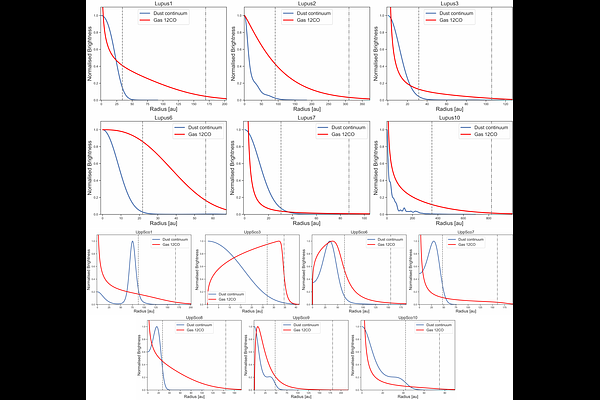The ALMA Survey of Gas Evolution of PROtoplanetary Disks (AGE-PRO): X. Dust Substructures, Disk Geometries, and Dust-disk Radii

The ALMA Survey of Gas Evolution of PROtoplanetary Disks (AGE-PRO): X. Dust Substructures, Disk Geometries, and Dust-disk Radii
Miguel Vioque, Nicolás T. Kurtovic, Leon Trapman, Anibal Sierra, Laura M. Pérez, Ke Zhang, Pietro Curone, Giovanni P. Rosotti, John Carpenter, Benoît Tabone, Paola Pinilla, Dingshan Deng, Ilaria Pascucci, James Miley, Carolina Agurto-Gangas, Lucas A. Cieza, Rossella Anania, Dary A. Ruiz-Rodriguez, Camilo González-Ruilova, Estephani E. TorresVillanueva, Aleksandra Kuznetsova
AbstractWe perform visibility fitting to the dust continuum Band 6 1.3 mm data of the 30 protoplanetary disks in the AGE-PRO ALMA Large Program. We obtain disk geometries, dust-disk radii, and azimuthally symmetric radial profiles of the intensity of the dust continuum emission. We examine the presence of continuum substructures in the AGE-PRO sample by using these radial profiles and their residuals. We detect substructures in 15 out of 30 disks. We report five disks with large ($>$15 au) inner dust cavities. The Ophiuchus Class I disks show dust-disk substructures in $\sim80\%$ of the resolved sources. This evidences the early formation of substructures in protoplanetary disks. A spiral is identified in IRS 63, hinting to gravitational instability in this massive disk. We compare our dust-disk brightness radial profiles with gas-disk brightness radial profiles and discuss colocal substructures in both tracers. In addition, we discuss the evolution of dust-disk radii and substructures across Ophiuchus, Lupus, and Upper Scorpius. We find that disks in Lupus and Upper Scorpius with large inner dust cavities have typical gas-disk masses, suggesting an abundance of dust cavities in these regions. The prevalence of pressure dust traps at later ages is supported by a potential trend with time with more disks with large inner dust cavities (or "transition disks") in Upper Scorpius and the absence of evolution of dust-disk sizes with time in the AGE-PRO sample. We propose this is caused by an evolutionary sequence with a high fraction of protoplanetary disks with inner protoplanets carving dust cavities.